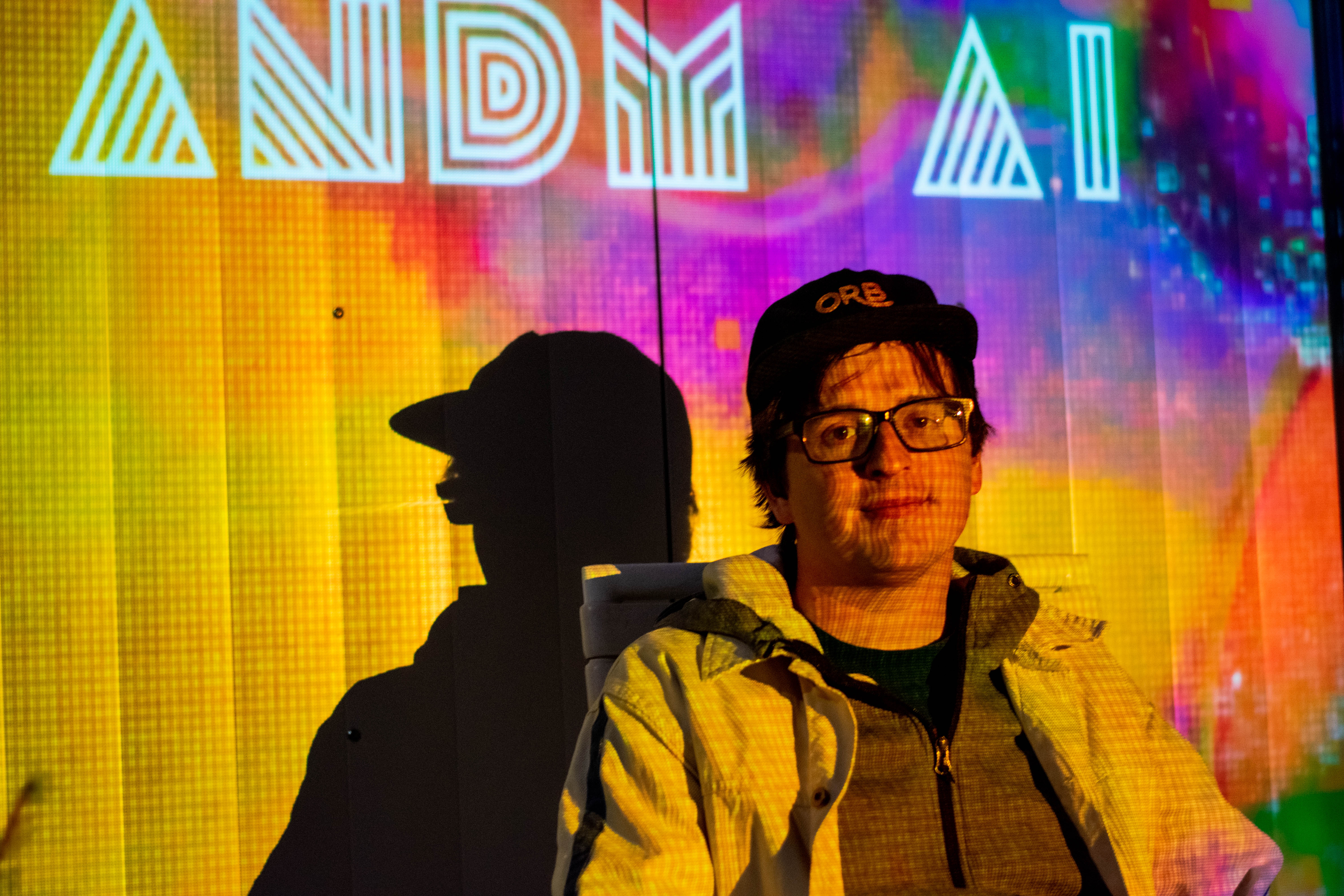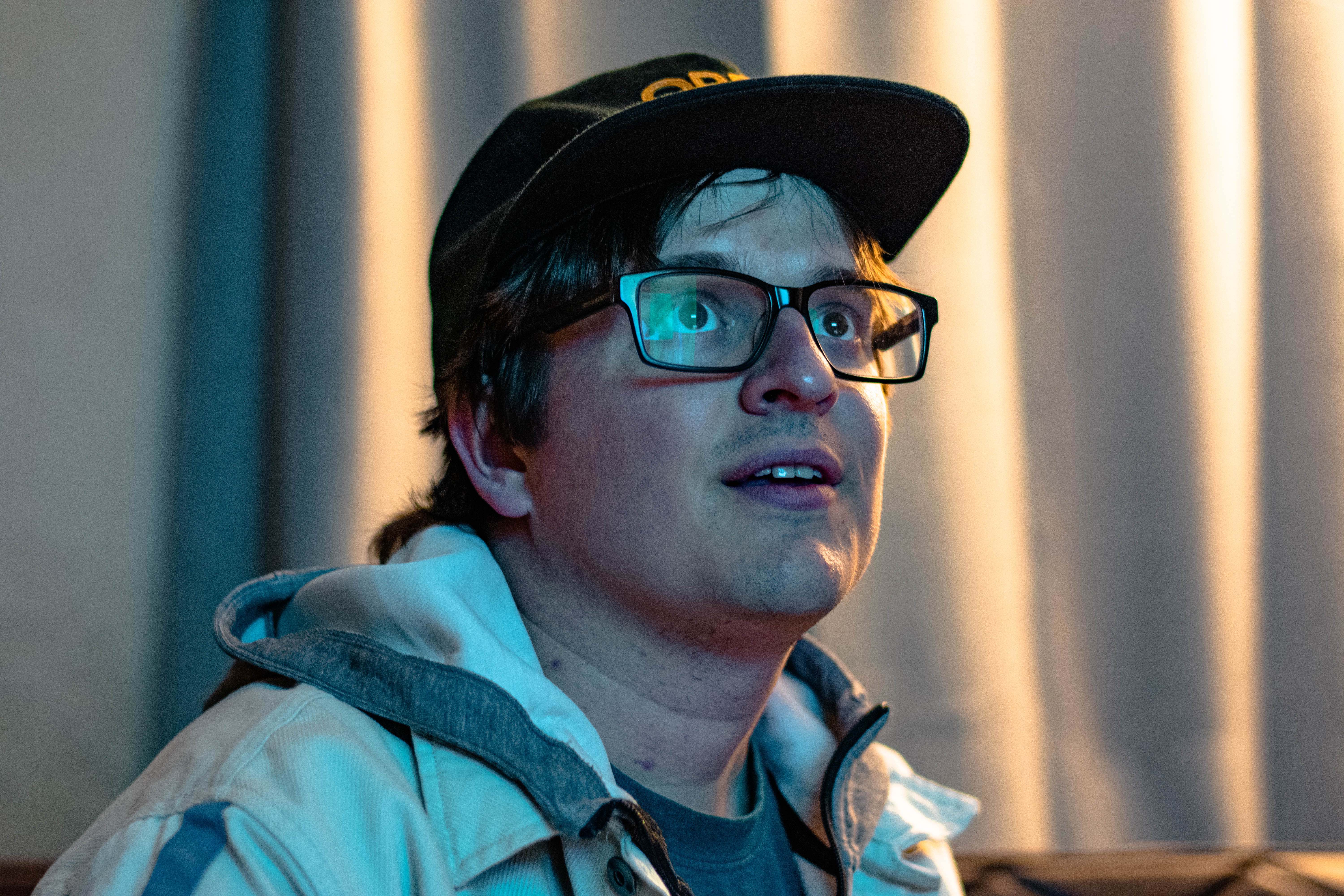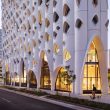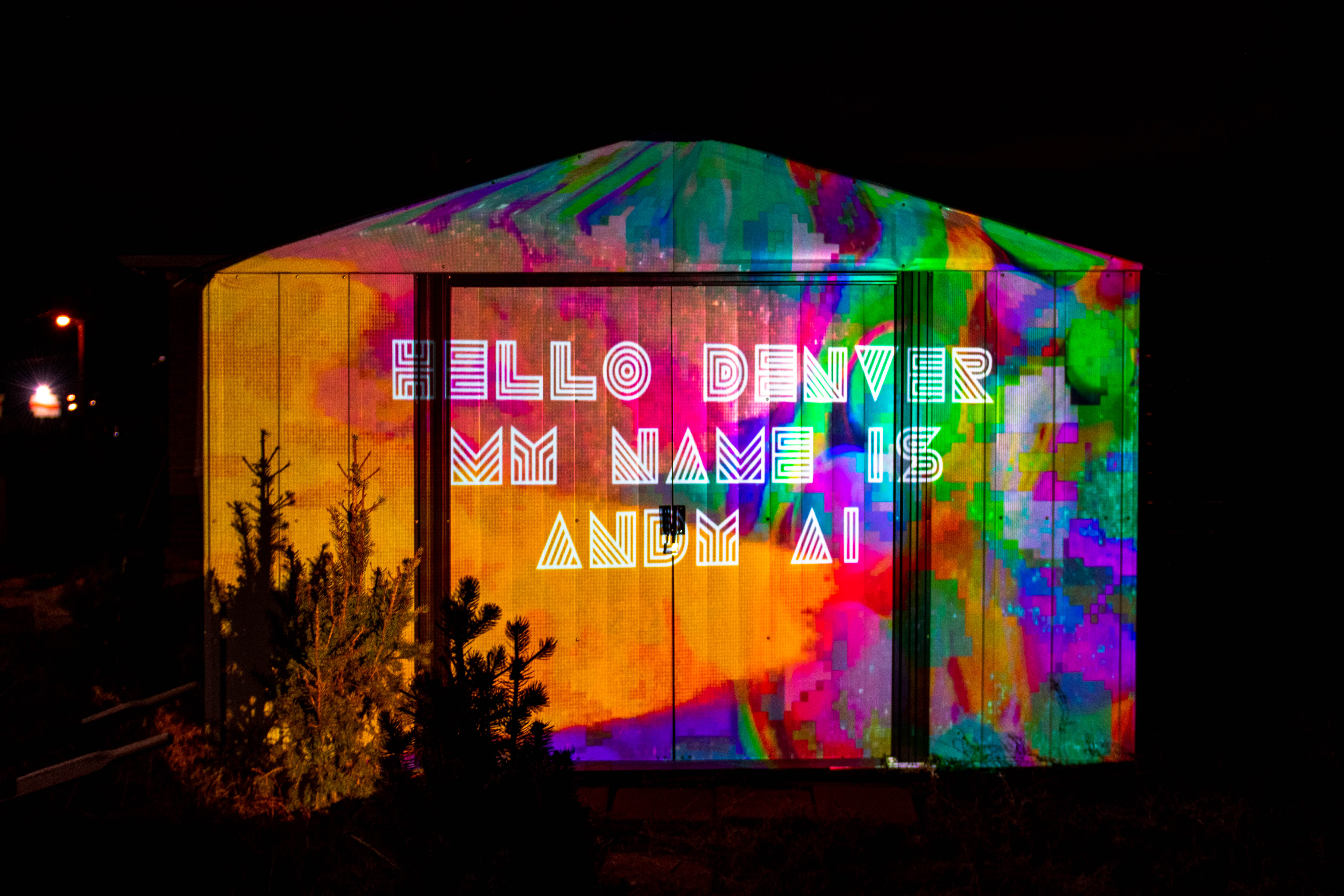Welcome to our series, Hello Denver, My Name is… where we profile different people in Denver you probably don’t know, but should. Get ready to meet painters, dancers, comedians, musicians, designers and just generally fascinating people that help make Denver awesome.
This all begins with that commonplace almost Matrix-like feeling you get when someone mentions a new person, place, or thing, and suddenly, you’re seeing the name everywhere, realizing how in-your-face this has always been. If you’re paranoid enough, it feels like glitches in your simulation — I am paranoid enough, in case you’re wondering. If you’re logical enough, you realize that the world has always had this around, your brain has just chosen to ignore it, filing it away in the unknown parts of the world it’s too lazy to go through.
Andrew Ininns lives in-between both versions of this phenomenon. An enigma of sorts, his indescribable work is something you can only really see to know, and yet, he’s always been here. Him and the people behind-the-scenes are always around, doing the work that you attribute to a great performance by your favorite musician, but instead scan away and focus on the music, man. Not that that’s bad. He won’t say that. But I will, because in Denver we live in a world beyond what’s right in front of us when it comes to art.
Ininns, who goes by Andy AI on social media and on most projects he creates in the Denver music scene, is an artist without a title. He creates his own visual projections in real-time, tinkering with software live, making the visuals their own form of impromptu music that is perfectly tailored to every performance. He’s worked with over 40 bands so far in Denver, many of them part of the tight-knit local community that leap over the safe haven of predisposed smaller-scale expectations, leaning in on the strange to create something truly one-of-a-kind. Ininns wants to make them shine, and in doing so, he shines too — it’s just harder to quantify because the affirmation doesn’t come through raucous applause at the end of a musical number.
Nonetheless, his work is incredibly important, and what he represents — the background to the art world we get to enjoy with the innocence of an ignorant bystander — is cause for even more praise. In a world of flashy representation, his work is a beating heart of authenticity just beneath the surface.
Denver, meet Andrew Ininns.
.

Andrew Ininns: I guess everybody’s seen it, but, it’s not conventionally something people talk about. It doesn’t really have a name for it, I guess, which is kind of a weird thing. Like everybody knows what a musician is and all the instruments and everything, but I guess the best word for it is like a “visualist” or a visual designer. In terms of the actual software behind it, I use Ableton and Resolume which is basically the base program. I also use a bunch of smaller software including one called Synesthesia, which is a really cool audio visualizer. So I’m live. I play with bands and I basically play the visuals that are behind the band as if they were kind of a live instrument. I try and play it as live as possible. So I’ll use some things that are generated via audio and stuff like that. But for the most part, it’s kind of triggered in the moment. So it’s kind of fun.
303: So you’re basically performing alongside the musicians that you’re working with as much as possible. Do you go to these rehearsals and kind of fine-tune things or is it all mostly on the spot, completely spontaneous improvisation?
AI: It’s a little bit of both. It really depends on what’s going on. Usually, for album releases and that kind of thing, we will do some kind of rehearsals or try and get together a little bit just so that they can help me carry what it will ultimately look like.
303: What got you into that?
AI: I went to school for lighting, but lighting engineering, so I was very architecturally focused and then kind of moved a little bit into the entertainment side. At the same time, I was in bands from 2004 onwards, probably pretty much as long as I could remember. Then I moved back to Denver five years ago and didn’t necessarily want to just keep being in bands for the rest of my life. So I was kind of looking for a new outlet that was still kind of in the music industry. Or the music scene I guess more than the industry. So in 2016, I started playing with a few bands, just doing lights and stuff and then kind of discovered the visual side of things and really fell in love with that. I started working with DeCollage a lot, went on a tour with them, and then kind of just started working with a lot of different bands after that. I think I’ve played with around 40 bands so far in Denver.
303: Do you also create your own visual projections or use presets available with the software? How does that work?
AI: Yes, I do make my own. The software, once you get it, allows for some really cool stuff. But what is even more fun for me, is sometimes I’ll just take something that already exists that I’m allowed to use and kind of use it as a stencil to some degree and then like put a generative texture behind it or something like that. So it’s a kind of experimentation I would say. Lately, I’ve been doing a lot of stuff where I’ve been manipulating public domain files. So everything before 1926, everything that people just forgot to renew their rights to, just trying to figure out how to do something creative with that where it’s not like I’m just stealing art, I’m just making it my own, you know? It’s been really fun. I have some really cool stuff coming out next year that I’m really excited about.
303: Well that’s a perfect transition to the next question. What projects do you have in the works for 2020?
AI: I’m working on my own project. I’ve been working with Justin Mars from, or Jay Marz, I guess he goes by. He’s been helping me out with some of the music for it and I’m getting back into music a little bit for it. And then there’s a public domain project that I’m working on, basically editing a short film out of these graphics I’ve made. That’s going to be awesome. And then all these music videos, I’m trying to do a lot more just short form content. So putting stuff on Instagram and stuff like that, you know, creating accessibility for the name because my work can often be very behind-the-scenes. I’m working on a lot of things that I’m really excited about, but I do want to like keep the core of my work in the live shows cause that’s been really wonderful to me so far.
303: So when you say you’re working on music videos, how so?
AI: Well I directed a video for Motion Trap, but I also recently helped with the visuals for Neoma’s music video “Into You.” For me, I don’t think that I’ll ever be a full-time music video director or anything like that anytime soon. I think it’s more just me trying to get the kinds of things that I do in the venue setting [but] in front of more people in a more accessible platform. Because it’s a very magical feel in the venue setting, but then only a few people see that and they’re usually more focused on what else is going on. Social media and music videos give it a different life, a different lens that more people can see and appreciate.
303: So Neoma’s newest music video was also directed and shot by Julianna Williams who does a lot of concert photography in Denver, and it was put on by Future Garden the agency which is run by Kyle Hartman. Basically what I’ve noticed is that there seems to be a very collaborative nature to the scene here and you seem to be right in the middle of it. Is that an accurate description?
AI: Yeah, definitely. Most of the people we’ve talked about are now my best friends. The only people I want to work with, honestly. I’ve worked with some like pop groups and stuff like that, like people who are a little bit more mainstream and I find that a lot harder. Honestly, because they seem to be less interested in collaborating and more trying to push their vision, which they should be. That’s their right to do that, but it’s very different than what we’re doing. And that’s what Denver is really all about. Everybody wants to help each other all the time. Everybody’s always working on things together. And I think it’s really beautiful. It’s something that if you go to other music scenes, you don’t necessarily see, they probably exist to some degree, but Denver has something special.
303: You’ve mentioned you used to be in bands since you can remember, do you still make music? Does that still play a big role in your life?’
AI: It’s been less of a priority for me as a been working on more visual stuff. But yeah, I started off in bands in the 2000s and had a band around Denver and Boulder called the AI project. We were around for like four or five years. We got some great shows and worked with a lot of great people. But then I moved out to Atlanta [Georgia] for a job and deejayed and did lighting with a lot of friends from the lighting school. So we were throwing shows, like house shows in Atlanta in our living room, and that was an incredible time. But I moved back here and started focusing entirely on the lighting side of things and haven’t really looked back. I think I will always like to make music, but I don’t really want to be like a frontman of a band or anything. That’s not for me. I do want to make some like small releases and that kind of thing, but that’s about it.
303: You have a living room full of records, and considering your past as a DJ, if you had to pick three records you love right now out of your collection, what would they be?
AI: I really like Son Lux’s album We Are Rising. He made it in like two weeks or something and it’s just a really beautiful collaborative effort with a lot of different people and it was kind of like the first one that he broke out on. A lot of, pretty much everything on NPR was his music for like three years because he just made this really beautiful album that could also kind of be used as background music and it’s just a really powerful album. Something that I really cherish. And Caribou’s album Swim is fantastic. And for the third, I would probably go with BRAIDS. They have this double album that’s really incredible that I have on vinyl that I just love. [Flourish/Perish.] My sister gave it to me that a few years ago. It was their second album, so they were a four-piece and then they went down to a three-piece and their work as a four-piece is really cool and really artistic and interesting. But they went for this completely different sound on their second one where it’s very contemplative and something that I’ve fallen asleep to on an airplane so many times I can’t count.
303: I have to ask. Is there anything that you want to convey with this profile that we haven’t talked about already? About you or about the scene or anything that you feel like you need to say?
AI: Yeah, totally. I think the biggest thing for me is, there’s just a lot of people working on things. I mean, so many people work on a show when you’re watching it. And I think people don’t really see that necessarily. And, as I said, maybe they shouldn’t see that, but it’s kind of weird to be an artist working on a show and nobody really knows you’re working on the show. I’ve had so many people in bars come up to me and be like, “Hey, um, can you turn up the bass or something?” It’s like, no, that’s not my job. That’s not what I’m working on right now. And the people that are doing sound and other technical elements are amazing too, but that’s not who I am. I think there’s a lot of people working on a lot of things in Denver that are doing so many cool things, which is obviously what this whole like series is about. Highlighting people who are doing cool things that you don’t necessarily think about is a great concept. We have so much of that and it’s very rich and Denver. I would get frustrated when people say that we don’t have a great music scene or a great art scene or whatever. It’s just like, it’s not even that far below the surface. All you have to do is look.

303: The final question is from our previous interviewee, Scott Hildebrandt: “If you could be any sandwich, what sandwich would you be and why?”
AI: Great question. So at this vegan restaurant called Beet Box, they have a great sandwich called the ABC. It’s almonds, beets and cream cheese. It’s just like the perfect combination of flavors. We’ve been trying to eat no meat, basically, so we go to all the vegan places as much as we possibly can. And the ABC is just such a perfect sandwich. It’s just got like sweet and savory and crunchiness and just everything. So that’s kind of what I would like to do cause I want to just be sweet and savory.
This interview has been condensed and edited for clarity.





